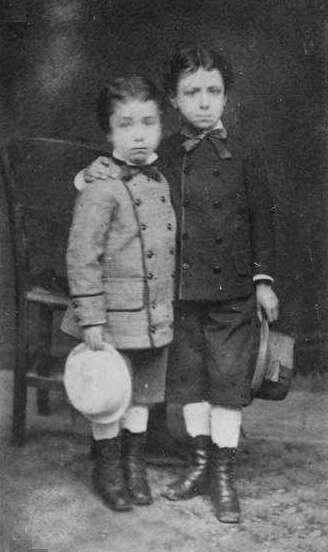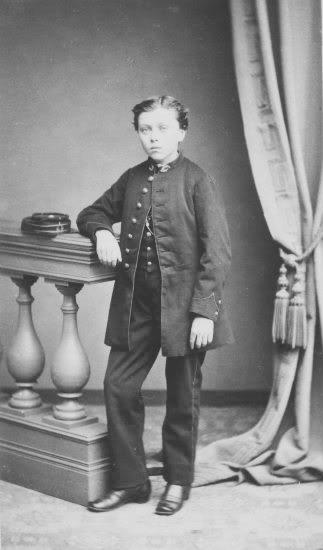
French Boys Suits: Chronology--The 19th Century
Skeleton suits worn with long pants were the classic style for boys in the early-19th century. Other than the skeleton suit we have little information on the early-19th century. We note boys wearing tunics and peaked caps with tassles. Unfortunately we have been able to find little information about suits. Even though commercial photography was developed in France with the Daguerreotype (1839) we have foind very few early French photographs. Only with the appearance of the CDV in large numbers (1860s) do we have a hotograohic recor to build a detailed chronology. We see many of the same styles in France that we see in the rest of Europe and Notth America. France was very important in setting women's fashions. While it was less important in male fashion trends, France's influence should not be discounted. Many boys wore collar-buttoning jackets at mid-century, mostly very plain suits. Vests were very common. We note cut-away jackets for younger boys in the 1860s. These were mostly short jackets, but we also notice longer cuts like the boy here is wearing in the early-1870s (figure 1). Collar buttoning jackets seemed to have declined in the 70s and in addition to the cut-away jackets, we see more boys wearing lapel sack suits. Some were fancy suits. The inspiration for the Amnerican Fauntleroy suit was the fancy suits Mrs. Burnett saw French boys wearing while she was living in Paris. And increasingly boys were wearing shortened-length pant with suits, mostly worn with long stockings. We begin to see the shortened-length pants worn with socks (1880s). Suits were not as common in France as many other countries, we think the fact that children wore smocks to school was a factor.
The 1800s
Skeleton suits worn with long pants were the classic style for boys in the early-19th century. Other than the skeleton suit we have little information on the early-19th century.
The 1830s
We note boys wearing tunics and peaked caps with tassles.
The 1850s
Unfortunately we have been able to find little information about suits at mid-century. Even though commercial photography was developed in France with the Daguerreotype (1839) we have found very few early French photographs. Unlike America, we have been able to find very few Frech Dags or Ambros. The CDV appeared in France (1850s, but at first for some reason was not very popular. Many boys as best we can tell wore collar-buttoning jackets at mid-century, mostly very plain suits. Unfrtuntely as Dags and Ambros were not nearly as commln in France as in america, we have very few examples of French boys' sits from the 1850s.

Figure 7.--Here we see two boys wearing collar-buttoning jackets with double-breasted styling and knee pants. The CDV portrait is undated. The style of the nount and the white stockings suggest the 1860s to us. Knee pants suits were popular for younger boys, but we mostly see oldr boys wearingg long pants suits. .
|
|
The 1860s
We know much more about the French fashions in the 1860s than any other period in French history. Only with the appearance of the CDV in large numbers (1860s) do we have a photographic record to build a detailed chronology. The CDV was a popular sensation. We sudently have a huge amount of information bout European fashions. We see French boys wearing many of the same styles that we we see in the rest of Europe and North America. France was very important in setting women's fashions. While it was less important in male fashion trends, France's influence should not be discounted. One aspect we are not sure about is to what extent Frech boys wore suits in the 1860s. The photographic record suggests that most boys after breeching did so. Of course the fmilies most likely to have portraits done are middle-class and well-to-do families. We note both cut-away and collar jackets for younger boys in the 1860s. The collar buttoning jackets included some rather stylish ones, including ones with double breasted jackes tht we see here (figure 7). We note modest detailoing such as piping in the jackets. Vests were very common ith the cut-away jackes. Knee pants were worn by younger boys, but most older boys wore long pants suits. A major shift from the 1850s was the matching convdentions. Most boys wore suits in which the jacket and pants matched, using the same material and color. This conventionfor som reason was adopted very abruptly an on other countries as well. Matching jackets and pants were not very common in the 1840s abd 50s. We are unsure hat pompted this. The knee pants suits were worn with long stockings, mostly white long stockings. White long stockings were very commn in other countries as well.

Figure 8.--Here we see what we believe is a military-styled school uniform. Note the kepi cap on the banister. The boy is identified on the back, but the name is virtully impossible to read. The CDVportrait is undated, but we would date to he late-60s or early-70s. The studio is Porgeron in Fontenbleau.
|
|
Cut-away jackets coninued to be worn by younger French boy n the 1870s. These were mostly short jackets, but we also notice longer cuts like the military style jcket the boy here is wearing in the early-1870s (figure 8). Collar buttoning jackets seemed to have declined in the 70s and in addition to the cut-away jackets, we see more boys wearing lapel sack suits. Some were fancy suits. Long pants suits for older boys were still common, but we note-shortened-length suits increasing in popularity, especially among well-to-do fashionable families. We see boys in America, Britain, and we think Germany (we are still looking into this) wearing suits to primary schools in the 1870s. And we begin to see striped long stockings replacing the white long stockings that were so common in the 60s. This was less true in France where children began wearing smocks. This was mandated by the new French Republic which took power in the country as a result of the fall of the monrarchy as a result of the Franco-Prussian War. One impact was clearly seen in French schools. We see boys wearing military-looking suits in the 1870s. With all the talk of German militarization, it was rench boys that wore military uniforms to school. We believe that this was in part a reaction to the disatrous Franco-Prussian War and the loss of Alsace-Loraine. The disaster of the War shocked France to the core. And there were many reperscussions, not the least in fashion. The idea of the new French Republic was the perceived need to restore discipline among the youth. These seem to be mostly school uniforms for secondary schools. The unidentfied boy here is a good example (figure 8).
The 1880s
We see more French boys wearing shortened-length pants in the 1880s, including more older boys. The inspiration for the Amnerican Fauntleroy suit was the fancy suits Mrs. Burnett saw French boys wearing while she was living in Paris. And increasingly boys were wearing shortened-length pant with suits, mostly worn with long stockings. We begin to see the shortened-length pants worn with socks (1880s). Suits were not as common in France as many other countries, we think the fact that children wore smocks to primary school was a factor. We suspect tht economics was a nother factor. A suit was a relatively expensive garment. We continue to see boys wearing military-styled school uniform suits. These were always done with long pants.
The 1890s
Shotened lengthpants increased in popularity for lder boys during the 1890. And e see knckes as opposed to knee pants becoming the dominant style.
HBC

Navigate the Boys' Historical Clothing Web Site:
[Introduction]
[Activities]
[Biographies]
[Chronology]
[Cloth and textiles]
[Clothing styles]
[Countries]
[Topics]
[Bibliographies]
[Contributions]
[FAQs]
[Glossaries]
[Images
[Links]
[Registration]
[Tools]
[Boys' Clothing Home]
Navigate the Boys' Historical Clothing French pages:
[Return to the Main French suit chronology pge]
[Return to the Main French suits page]
[Return to the Main French garment page]
[French choirs]
[French school uniforms]
[French school smocks]
[French royalty]
[French sailor suits]
[French youth group uniforms]
[Difficult French images]
[French art]
[French Movies]
[French ethnics]
Created: 6:46 PM 3/28/2014
Last updated: 4:09 AM 10/30/2017




